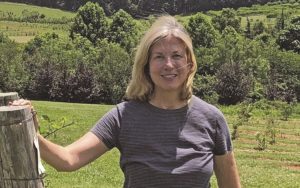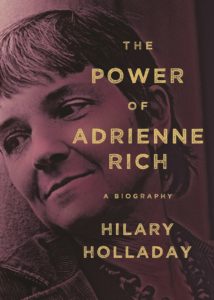Hilary Holladay’s The Power of Adrienne Rich is an accessible biography of the celebrated American poet. Published last month, it is the first comprehensive exploration of both the person and her poetry.
Rich, who died in 2012 at 82, published nine books of nonfiction and more than two dozen volumes of poetry, including Diving Into the Wreck, Of Woman Born: Motherhood as Experience and Institution, The Dream of a Common Language, and A Wild Patience Has Taken Me This Far. Her accolades include a National Book Award, a National Poetry Association Award for Distinguished Service, a MacArthur Fellowship, and awards and honorary degrees from Yale, Harvard, Brandeis, and Swarthmore.
Though Rich herself chronicled the many iterations of her own identity, she left plenty of room for evaluation and interpretation. It is her near-constant re-invention of self that most interests Holladay.

A talented formalist with a mastery of classical poetry, Rich, while still an undergraduate at Radcliffe, won the Yale Younger Poets Prize in 1950. She encountered early second-wave feminism in Cambridge and, by the 1960s, cast herself in opposition to academia and the patriarchy. After bearing three sons and leaving her marriage, Rich declared herself a radical lesbian feminist in the 1970s. But by the 1990s, she had decided that “women’s liberation,” as well as Marxist-influenced human liberation, informed her worldview — not feminism. Her last re-envisioning led her to Judaism, which she reclaimed from her Jewish father, whom she had long since rejected.
“She had made a Talmud out of her life,” writes Holladay, “the multiple meanings of which demanded endless study, debate, and interpretation.”
Another biographer might have questioned such shape shifting, but Holladay chose to meet Rich respectfully where she was at any given time, exploring her “fierce, roiling mind.” Holladay likens Rich’s many shifts in self-conception to “coming out,” each a brave “writing and rewriting, righting and re-righting, the truths of her own story, her life.” Holladay’s nuanced explication of Rich’s poetry deepens the reader’s appreciation of this iconoclastic American artist.
Holladay does not shy away from the ways that Rich’s identities complicated her literary and political friendships with writers such as Audre Lord, Robin Morgan, Denise Levertov, Hayden Carruth, Donald Hall, and Lucille Clifton. Add to this list Rich’s sexual and romantic relationships — from her husband, the economist Alfred Conrad, who killed himself, to life partner Michelle Cliff — and the book provides a wide-angle lens on the poet’s long life.
Holladay addresses Rich’s legendary anger and her tendency to drop family and friends. She interviewed more than 100 people for the book, turning to manuscript collections and personal correspondence to fill in gaps, which makes characters vivid and relationships relevant.
If it’s important to ask who Rich was to herself and to her friends and lovers, it’s hard to understand why Holladay did not ask who Rich was to her three sons. They show up infrequently in the book and are not mentioned in acknowledgments or sources. Rich left her sons when she left her husband, arguing that domesticity was smothering her. Holladay writes that some “would likely say she abandoned her children, but she wouldn’t let that prevent her from doing what felt right to her.”

Given Rich’s agreement with Robin Morgan that “the personal is political,” and given Rich’s treatise on motherhood, the groundbreaking Of Woman Born, it’s hard to argue that this aspect of Rich’s life is irrelevant. Perhaps, given that Rich insisted she be evaluated on her work as a poet, not a mother, Holladay chose to concentrate on Rich and her writing. Or perhaps Rich’s sons declined to speak. In any case, Holladay should have explained why Rich’s children and grandchildren appear but briefly in this exhaustively researched biography.
I found one truly inexcusable aspect of The Power of Adrienne Rich. Holladay repeatedly asserts that various characters “look Jewish.” Regarding a photograph of Rich, Holladay writes, “Her nose is prominent, and she has her father’s deep-set eyes. Just as [Rich’s father’s] appearance was recognizably Jewish, in this picture Adrienne herself looks Jewish.” Holladay makes much of Rich’s husband’s change of last name from Cohen to Conrad, as well as his “cosmetic surgery, which made his nose appear less recognizably Jewish.” Had she put her descriptions in historical context, ascribing presumptions about identity during a time when such elisions were common and socially acceptable, Holladay might have avoided perpetuating baseless stereotypes.
It is hard to accept that no one on Doubleday’s staff — from publisher and editorial director Nan A. Talese down to nameless proofreaders — offered objections. I’d like to think that were Rich alive, she would by now have generated yet another self which would loudly have denounced Holladay’s use of an anti-Semitic trope.



